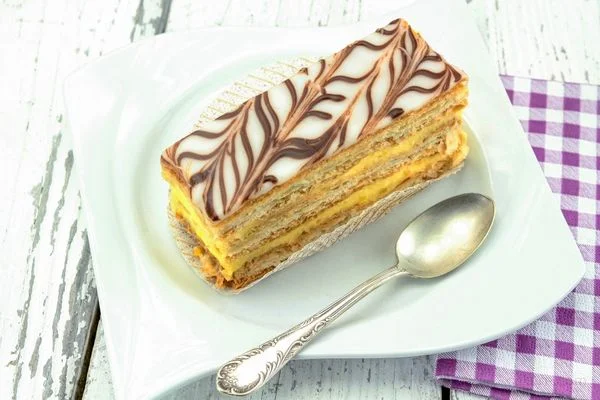Feuille cake, also known as mille-feuille or Napoleon pastry, is a French dessert made from layers of crispy puff pastry, creamy filling, and topped with a dusting of powdered sugar. Its name means “thousand leaves” in French, referring to the many layers of pastry that make up the dessert.
Although it is now a beloved pastry around the world, its origins can be traced back to medieval Europe. In this article, we’ll delve into the fascinating history of feuille cake, exploring its evolution over time and its place in the cultural traditions of many countries.

- The Origins of Feuille Cake
- The Rise of Feuille Cake in France
- The Spread of Feuille Cake Around the World
- Feuille Cake in Modern Times
- Ingredients and Techniques for Making Feuille Cake
- The Cultural Significance of Feuille Cake
The Origins of Feuille Cake:
Feuille cake has its roots in the Middle Ages, when a similar pastry known as a “thousand-leaf” cake was made in Arabic countries. The cake was brought to Europe during the Crusades, and over time it evolved into the pastry we know today. In the 16th century, the French chef François Pierre de La Varenne created a version of the cake that included layers of puff pastry, cream, and fruit, and called it mille-feuille. It quickly became popular among French aristocracy and remained a delicacy for centuries.
The Rise of Feuille Cake in France:
During the 19th century, feuille cake became a symbol of French elegance and sophistication. The pastry was often served at formal events and became a favorite of high society. The French writer Marcel Proust even mentioned mille-feuille in his famous novel “In Search of Lost Time,” describing it as a “heavenly pleasure.”
The Spread of Feuille Cake Around the World:
As French cuisine became popular around the world, feuille cake traveled with it. In Italy, the pastry is known as millefoglie and often includes layers of sweetened ricotta cheese. In Spain, it is called milhojas and is often filled with pastry cream or dulce de leche. In Japan, it is known as “Napoleon” and is often served as a birthday cake.
Feuille Cake in Modern Times:
Today, feuille cake remains a popular dessert around the world, beloved for its delicate layers and creamy filling. It has been adapted in many different ways, with variations that include chocolate, fruit, and even savory ingredients like smoked salmon and goat cheese.
Ingredients and Techniques for Making Feuille Cake:
Making feuille cake can be a time-consuming and delicate process, but the result is well worth the effort. The key to a successful feuille cake is in the puff pastry, which must be carefully rolled out and folded to create the many layers. The filling can be made with a variety of ingredients, including pastry cream, whipped cream, fruit, or chocolate.
The Cultural Significance of Feuille Cake:
Feuille cake has become more than just a delicious dessert – it is now an important part of the cultural traditions of many countries. In France, it is often served on special occasions like weddings and birthdays. In Japan, it is a popular dessert for Christmas and New Year’s
FAQs
Feuille cake and mille-feuille are essentially the same thing. Mille-feuille is the French name for the pastry, while feuille cake is a more generic term that is used in other countries.
Making feuille cake requires some skill and patience, particularly when it comes to the puff pastry. However, with the right recipe and technique, it can be a rewarding and delicious dessert to make at home.
Yes, there are many gluten-free pastry options available that can be used to make feuille cake. However, it may require some experimentation to find the right recipe and technique.
Conclusion
Feuille cake is a timeless dessert that has evolved over centuries, from its origins in medieval Europe to its place as a beloved pastry around the world. Its delicate layers of puff pastry and creamy filling have made it a symbol of elegance and sophistication, and its enduring popularity is a testament to its delicious flavor and cultural significance. Whether enjoyed at a formal event or as a homemade treat, feuille cake is a sweet delight that continues to capture the hearts of pastry lovers everywhere.
